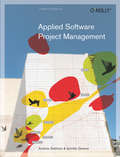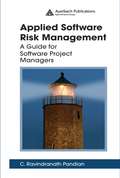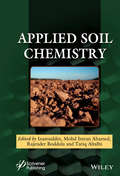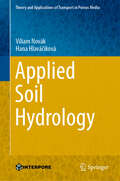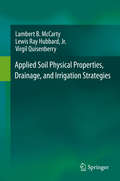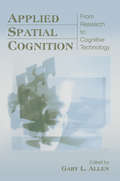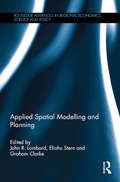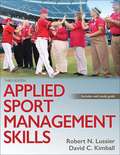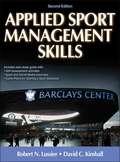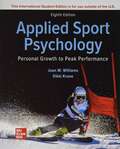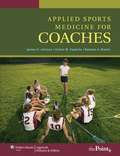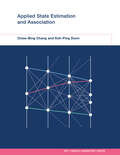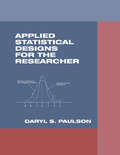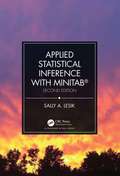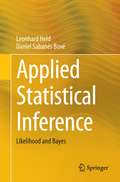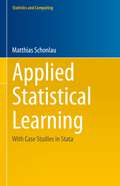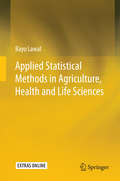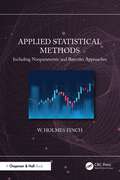- Table View
- List View
Applied Software Project Management
by Jennifer Greene Andrew Stellman"If you're looking for solid, easy-to-follow advice on estimation, requirements gathering, managing change, and more, you can stop now: this is the book for you."--Scott Berkun, Author of The Art of Project ManagementWhat makes software projects succeed? It takes more than a good idea and a team of talented programmers. A project manager needs to know how to guide the team through the entire software project. There are common pitfalls that plague all software projects and rookie mistakes that are made repeatedly--sometimes by the same people! Avoiding these pitfalls is not hard, but it is not necessarily intuitive. Luckily, there are tried and true techniques that can help any project manager.In Applied Software Project Management, Andrew Stellman and Jennifer Greene provide you with tools, techniques, and practices that you can use on your own projects right away. This book supplies you with the information you need to diagnose your team's situation and presents practical advice to help you achieve your goal of building better software.Topics include:Planning a software projectHelping a team estimate its workloadBuilding a scheduleGathering software requirements and creating use casesImproving programming with refactoring, unit testing, and version controlManaging an outsourced projectTesting softwareJennifer Greene and Andrew Stellman have been building software together since 1998. Andrew comes from a programming background and has managed teams of requirements analysts, designers, and developers. Jennifer has a testing background and has managed teams of architects, developers, and testers. She has led multiple large-scale outsourced projects. Between the two of them, they have managed every aspect of software development. They have worked in a wide range of industries, including finance, telecommunications, media, nonprofit, entertainment, natural-language processing, science, and academia. For more information about them and this book, visit stellman-greene.com
Applied Software Risk Management: A Guide for Software Project Managers
by C. Ravindranath PandianFew software projects are completed on time, on budget, and to their original specifications. Focusing on what practitioners need to know about risk in the pursuit of delivering software projects, Applied Software Risk Management: A Guide for Software Project Managers covers key components of the risk management process and the software development
Applied Soil Chemistry
by Inamuddin Mohd Imran Ahamed Rajender Boddula Tariq AltalhiThis book explores the state-of-the-art information regarding applied soil sciences. It covers the fundamentals, model concepts, principles, chemical reactions, functions, chemical recycling, chemical weathering, acid-base chemistry, carbon sequestration, and nutrient availability of soils. Also, it includes soil chemistry of heavy-metals, environment, clay, ion-exchange processes, analytical tools and applications. This book helps to understand the about soil characteristics targeting soil chemical reactions and interactions and its applications.
Applied Soil Hydrology (Theory and Applications of Transport in Porous Media #32)
by Viliam Novák Hana HlaváčikováThis state-of-the-art book clearly explains the basic principles of soil hydrology and the current knowledge in this field. It particularly highlights the estimation and application of measurements and evaluation of soil-hydrophysical characteristics using simulation models, with a focus on elucidating the basic hydrophysical characteristics of soil, such as soil water potential and hydraulic conductivity, as well as the methods of measurement. It also addresses topics such as stony soil, water repellent soils, and water movement modeling in those media. The book presents soil hydrology in a simple way, while quantitatively expressing the soil water state and movement. It clearly and precisely describes basic terms of soil hydrology with a minimum of mathematics. It also includes the latest research findings in the field as well as the basics of the mathematical modeling of water movement in the soil-plant-atmosphere system (SPAS), using original research results to illustrate these issues.This book is of interest to all scientists and professionals in soil hydrology, including beginners, as well as those interested and working in hydrology in general and soil hydrology in particular. In addition, it can also be used by specialists and students in related fields like agronomy, forestry, meteorology, hydrology, environmental engineering, environmental protection, and geography.
Applied Soil Physical Properties, Drainage, and Irrigation Strategies.
by Lambert B. Mccarty Lewis Ray Hubbard Jr. Virgil QuisenberryThe book is a realistic blend of basic knowledge and understanding in soil physical properties. It will enable the reader to scientifically analyze soils to develop practical and successful means of providing sufficient drainage and to develop science-based irrigation strategies. Only basic mathematical knowledge is necessary to understand and apply the proven principles covered. With limited resources that are increasing significantly in costs, the book blends the ideal concept of providing sufficient drainage and irrigation based on using soil physical properties but with financial limitations in mind. One traditional problem with many Soil Physics, Drainage, and Irrigations-based texts is the prerequisite of understanding complicated calculus-based mathematics. Although necessary for a theory-based text, our text was developed with practitioners in mind where such complicated mathematics was avoided but referenced if the reader wishes to further explore the specific topic. Another problem with many traditional texts is the lack of practical examples or case-studies allowing readers to relate their specific scenarios to similar types of situations. We have purposely included numerous examples and practical field experiences. This is especially true when many of the theoretical ideals are covered, followed by explanations of how such ideals can be applied in the laboratory and field.
Applied Spatial Cognition: From Research to Cognitive Technology
by Gary L. AllenApplied Spatial Cognition illustrates the vital link between research and application in spatial cognition. With an impressive vista ranging from applied research to applications of cognitive technology, this volume presents the work of individuals from a wide range of disciplines and research areas, including psychologists, geographers, information scientists, computer scientists, cognitive scientists, engineers, and architects. Chapters throughout the book are a testimony to the importance of basic and applied research regarding human spatial cognition and behavior in the many facets of daily life. The contents are arranged into three sections, the first of which deals with a variety of spatial problems in real-world settings. The second section focuses on spatial cognition in specific populations. The final part is concerned principally with applications of spatial cognitive research and the development of cognitive technology. Relevant to a number of remarkably diverse groups, Applied Spatial Cognition will be of considerable interest to researchers and professionals in industrial/organizational psychology, human factors research, and cognitive science.
Applied Spatial Data Analysis with R
by Roger Bivand Edzer J. Pebesma Virgilio Gómez-Rubio Roger S. BivandApplied Spatial Data Analysis with R is divided into two basic parts, the first presenting R packages, functions, classes and methods for handling spatial data. This part is of interest to users who need to access and visualise spatial data. Data import and export for many file formats for spatial data are covered in detail, as is the interface between R and the open source GRASS GIS. The second part showcases more specialised kinds of spatial data analysis, including spatial point pattern analysis, interpolation and geostatistics, areal data analysis and disease mapping. The coverage of methods of spatial data analysis ranges from standard techniques to new developments, and the examples used are largely taken from the spatial statistics literature. All the examples can be run using R contributed packages available from the CRAN website, with code and additional data sets from the book's own website. This book will be of interest to researchers who intend to use R to handle, visualise, and analyse spatial data. It will also be of interest to spatial data analysts who do not use R, but who are interested in practical aspects of implementing software for spatial data analysis. It is a suitable companion book for introductory spatial statistics courses and for applied methods courses in a wide range of subjects using spatial data, including human and physical geography, geographical information systems, the environmental sciences, ecology, public health and disease control, economics, public administration and political science.
Applied Spatial Data Analysis with R (Use R! #10)
by Virgilio Gómez-Rubio Roger S. Bivand Edzer PebesmaApplied Spatial Data Analysis with R, second edition, is divided into two basic parts, the first presenting R packages, functions, classes and methods for handling spatial data. This part is of interest to users who need to access and visualise spatial data. Data import and export for many file formats for spatial data are covered in detail, as is the interface between R and the open source GRASS GIS and the handling of spatio-temporal data. The second part showcases more specialised kinds of spatial data analysis, including spatial point pattern analysis, interpolation and geostatistics, areal data analysis and disease mapping. The coverage of methods of spatial data analysis ranges from standard techniques to new developments, and the examples used are largely taken from the spatial statistics literature. All the examples can be run using R contributed packages available from the CRAN website, with code and additional data sets from the book's own website. Compared to the first edition, the second edition covers the more systematic approach towards handling spatial data in R, as well as a number of important and widely used CRAN packages that have appeared since the first edition. This book will be of interest to researchers who intend to use R to handle, visualise, and analyse spatial data. It will also be of interest to spatial data analysts who do not use R, but who are interested in practical aspects of implementing software for spatial data analysis. It is a suitable companion book for introductory spatial statistics courses and for applied methods courses in a wide range of subjects using spatial data, including human and physical geography, geographical information science and geoinformatics, the environmental sciences, ecology, public health and disease control, economics, public administration and political science. The book has a website where complete code examples, data sets, and other support material may be found: http://www.asdar-book.org. The authors have taken part in writing and maintaining software for spatial data handling and analysis with R in concert since 2003.
Applied Spatial Modelling and Planning (Routledge Advances in Regional Economics, Science and Policy)
by John R. Lombard, Eliahu Stern and Graham ClarkeThis book highlights the extraordinary range of areas to which geographical analysis and spatial modelling can bring lessons and insights. It shows how these techniques have been used to address ‘real world’ issues that are of concern to international organisations, public agencies and businesses, as illustrated by actual funded projects that geographers have developed collaboratively with end-users. Applied Spatial Modelling and Planning shows how much geographical research is policy relevant to a wide variety of agencies through the use of GIS and spatial modelling in applied geography. The book’s chapters contain a cross-section of innovative applications and approaches to problem solving within five major domains of the dynamics of economic space, housing and settlements, population movements and population ageing, health care, and the environment. Using a number of case studies on the use of GIS and spatial modelling, this book demonstrates the fact that much of what is done by quantitative geographers is not only relevant within academia, but also has use in policy work. This book will appeal to an international audience interested in cutting-edge spatial modelling to better understand the processes involved in solving real problems.
Applied Spatial Statistics and Econometrics: Data Analysis in R (Routledge Advanced Texts in Economics and Finance)
by Katarzyna KopczewskaThis textbook is a comprehensive introduction to applied spatial data analysis using R. Each chapter walks the reader through a different method, explaining how to interpret the results and what conclusions can be drawn. The author team showcases key topics, including unsupervised learning, causal inference, spatial weight matrices, spatial econometrics, heterogeneity and bootstrapping. It is accompanied by a suite of data and R code on Github to help readers practise techniques via replication and exercises. This text will be a valuable resource for advanced students of econometrics, spatial planning and regional science. It will also be suitable for researchers and data scientists working with spatial data.
Applied Spectroscopy and the Science of Nanomaterials (Progress in Optical Science and Photonics #2)
by Prabhakar MisraThis book focuses on several areas of intense topical interest related to applied spectroscopy and the science of nanomaterials. The eleven chapters in the book cover the following areas of interest relating to applied spectroscopy and nanoscience: · Raman spectroscopic characterization, modeling and simulation studies of carbon nanotubes, · Characterization of plasma discharges using laser optogalvanic spectroscopy, · Fluorescence anisotropy in understanding protein conformational disorder and aggregation, · Nuclear magnetic resonance spectroscopy in nanomedicine, · Calculation of Van der Waals interactions at the nanoscale, · Theory and simulation associated with adsorption of gases in nanomaterials, · Atom-precise metal nanoclusters, · Plasmonic properties of metallic nanostructures, two-dimensional materials, and their composites, · Applications of graphene in optoelectronic devices and transistors, · Role of graphene in organic photovoltaic device technology, · Applications of nanomaterials in nanomedicine.
Applied Sport Management Skills
by David Kimball Robert Lussier<p>Applied Sport Management Skills, Third Edition With Web Study Guide, takes a unique and effective approach to teaching students how to become strong leaders and managers in the world of sport. Organized around the central management functions—planning, organizing, leading, and controlling—this third edition addresses the Common Professional Component topics outlined by the Commission on Sport Management Accreditation (COSMA). <p>The text explains important concepts but then takes the student beyond theories, to applying those management principles and developing management skills. This practical how-to approach, accompanied by unmatched learning tools, helps students put concepts into action as sport managers—developing the skills of creative problem solving and strategic planning, and developing the ability to lead, organize, and delegate.</p>
Applied Sport Management Skills 2nd Edition
by David C. Kimball Robert N. LussierApplied Sport Management Skills, Second Edition uses the four management functions of planning, organizing, leading, and controlling to teach students how to become strong leaders and managers in the world of sport. This comprehensive and fully updated text provides an overview of management topics with a unique focus on developing the skills necessary for managing sport organizations.
Applied Sport Psychology: Personal Growth to Peak Performance
by Vikki Krane Jean M. Williams ProfessorApplied Sport Psychology, Eighth Edition, presents to the reader sport psychological theories, strategies, and techniques used by coaches and sport psychologists to cultivate peak performance and personal growth. Williams and Krane bridge the gap between research and practice by using examples, exercises, case studies, and anecdotes―helping students to think more critically and to apply their knowledge to real-world situations. This Eighth Edition includes a new chapter on mindfulness in sport and updates that reflect the latest statistics and research from the field.
Applied Sport, Exercise, and Performance Psychology: Current Approaches to Helping Clients
by David TodApplied sport, exercise, and performance psychology practice has diversified considerably over the years, as consultants have explored various theoretical models to guide them in helping their clients. Applied Sport, Exercise, and Performance Psychology: Current Approaches to Helping Clients provides in-depth and critical coverage, from a global perspective, of the common approaches practitioners now use with clients. Chapters are supplemented with case studies showing the approaches in action. The text explores topics such as: Cognitive behavioural approaches Psychodynamics approaches Family systems therapy approaches Mindfulness approaches Practitioner training and development Cultural considerations in practice Evidence-based practice This text is a vital resource for students in applied sport psychology courses, sport and exercise science courses, and psychology and counselling courses. It is also an invaluable read for practicing applied sport, exercise, and performance psychologists, as well as coaches and parents with some background in psychology.
Applied Sports Medicine for Coaches
by James Johnson Esther Haskvitz Barbara BrehmWritten for coaches, this textbook explains what you need to know about sports medicine in order to integrate optimal performance training with an injury prevention program. Moreover, it helps you communicate effectively with health professionals and better understand the nature of an injury, its treatment, the injured athlete's limits, and his or her rehabilitation needs.
Applied State Estimation and Association (MIT Lincoln Laboratory Series)
by Chaw-Bing Chang Keh-Ping DunnA rigorous introduction to the theory and applications of state estimation and association, an important area in aerospace, electronics, and defense industries. Applied state estimation and association is an important area for practicing engineers in aerospace, electronics, and defense industries, used in such tasks as signal processing, tracking, and navigation. This book offers a rigorous introduction to both theory and application of state estimation and association. It takes a unified approach to problem formulation and solution development that helps students and junior engineers build a sound theoretical foundation for their work and develop skills and tools for practical applications. Chapters 1 through 6 focus on solving the problem of estimation with a single sensor observing a single object, and cover such topics as parameter estimation, state estimation for linear and nonlinear systems, and multiple model estimation algorithms. Chapters 7 through 10 expand the discussion to consider multiple sensors and multiple objects. The book can be used in a first-year graduate course in control or system engineering or as a reference for professionals. Each chapter ends with problems that will help readers to develop derivation skills that can be applied to new problems and to build computer models that offer a useful set of tools for problem solving. Readers must be familiar with state-variable representation of systems and basic probability theory including random and stochastic processes.
Applied Statistical Considerations for Clinical Researchers
by David CullifordThis essential book details intermediate-level statistical methods and frameworks for the clinician and medical researcher with an elementary grasp of health statistics and focuses on selecting the appropriate statistical method for many scenarios. Detailed evaluation of various methodologies familiarizes readers with the available techniques and equips them with the tools to select the best from a range of options. The inclusion of a hypothetical case study between a clinician and statistician charting the conception of the research idea through to results dissemination enables the reader to understand how to apply the concepts covered into their day-to-day clinical practice.Applied Statistical Considerations for Clinical Researchers focuses on how clinicians can approach statistical issues when confronted with a medical research problem by considering the data structure, how this relates to their study's aims and any potential knock-on effects relating to the evidence required to make correct clinical decisions. It covers the application of intermediate-level techniques in health statistics making it an ideal resource for the clinician seeking an up-to-date resource on the topic.
Applied Statistical Designs for the Researcher (Chapman & Hall/CRC Biostatistics Series)
by Daryl S. PaulsonShowcasing a discussion of the experimental process and a review of basic statistics, this volume provides methodologies to identify general data distribution, skewness, and outliers. It features a unique classification of the nonparametric analogs of their parametric counterparts according to the strength of the collected data. Applied Statistical Designs for the Researcher discusses three varieties of the Student t test, including a comparison of two different groups with different variances; two groups with the same variance; and a matched, paired group. It introduces the analysis of variance and Latin Square designs and presents screening approaches to comparing two factors and their interactions.
Applied Statistical Inference with MINITAB®, Second Edition
by Sally A. LesikPraise for the first edition: "One of my biggest complaints when I teach introductory statistics classes is that it takes me most of the semester to get to the good stuff—inferential statistics. The author manages to do this very quickly….if one were looking for a book that efficiently covers basic statistical methodology and also introduces statistical software [this text] fits the bill." -The American Statistician Applied Statistical Inference with MINITAB, Second Edition distinguishes itself from other introductory statistics textbooks by focusing on the applications of statistics without compromising mathematical rigor. It presents the material in a seamless step-by-step approach so that readers are first introduced to a topic, given the details of the underlying mathematical foundations along with a detailed description of how to interpret the findings, and are shown how to use the statistical software program Minitab to perform the same analysis. Gives readers a solid foundation in how to apply many different statistical methods. MINITAB is fully integrated throughout the text. Includes fully worked out examples so students can easily follow the calculations. Presents many new topics such as one- and two-sample variances, one- and two-sample Poisson rates, and more nonparametric statistics. Features mostly new exercises as well as the addition of Best Practices sections that describe some common pitfalls and provide some practical advice on statistical inference. This book is written to be user-friendly for students and practitioners who are not experts in statistics, but who want to gain a solid understanding of basic statistical inference. This book is oriented towards the practical use of statistics. The examples, discussions, and exercises are based on data and scenarios that are common to students in their everyday lives.
Applied Statistical Inference: Likelihood and Bayes
by Leonhard Held Daniel Sabanés BovéThis book covers modern statistical inference based on likelihood with applications in medicine, epidemiology and biology. Two introductory chapters discuss the importance of statistical models in applied quantitative research and the central role of the likelihood function. The rest of the book is divided into three parts. The first describes likelihood-based inference from a frequentist viewpoint. Properties of the maximum likelihood estimate, the score function, the likelihood ratio and the Wald statistic are discussed in detail. In the second part, likelihood is combined with prior information to perform Bayesian inference. Topics include Bayesian updating, conjugate and reference priors, Bayesian point and interval estimates, Bayesian asymptotics and empirical Bayes methods. Modern numerical techniques for Bayesian inference are described in a separate chapter. Finally two more advanced topics, model choice and prediction, are discussed both from a frequentist and a Bayesian perspective. A comprehensive appendix covers the necessary prerequisites in probability theory, matrix algebra, mathematical calculus, and numerical analysis.
Applied Statistical Learning: With Case Studies in Stata (Statistics and Computing)
by Matthias SchonlauThis textbook provides an accessible overview of statistical learning methods and techniques, and includes case studies using the statistical software Stata. After introductory material on statistical learning concepts and practical aspects, each further chapter is devoted to a statistical learning algorithm or a group of related techniques. In particular, the book presents logistic regression, regularized linear models such as the Lasso, nearest neighbors, the Naive Bayes classifier, classification trees, random forests, boosting, support vector machines, feature engineering, neural networks, and stacking. It also explains how to construct n-gram variables from text data. Examples, conceptual exercises and exercises using software are featured throughout, together with case studies in Stata, mostly from the social sciences; true to the book’s goal to facilitate the use of modern methods of data science in the field. Although mainly intended for upper undergraduate and graduate students in the social sciences, given its applied nature, the book will equally appeal to readers from other disciplines, including the health sciences, statistics, engineering and computer science.
Applied Statistical Methods in Agriculture, Health and Life Sciences
by Bayo LawalThis textbook teaches crucial statistical methods to answer research questions using a unique range of statistical software programs, including MINITAB and R. This textbook is developed for undergraduate students in agriculture, nursing, biology and biomedical research. Graduate students will also find it to be a useful way to refresh their statistics skills and to reference software options. The unique combination of examples is approached using MINITAB and R for their individual strengths. Subjects covered include among others data description, probability distributions, experimental design, regression analysis, randomized design and biological assay. Unlike other biostatistics textbooks, this text also includes outliers, influential observations in regression and an introduction to survival analysis. Material is taken from the author's extensive teaching and research in Africa, USA and the UK. Sample problems, references and electronic supplementary material accompany each chapter.
Applied Statistical Methods: Including Nonparametric and Bayesian Approaches
by W. Holmes FinchThis book is designed to provide students, teachers, and researchers with a text that includes a full range of statistical methods available to address commonly encountered research problems. Many textbooks for introductory, intermediate, and advanced statistics courses focus heavily on parametric methods. However, in practice, the assumptions underlying these methods are frequently not met, therefore calling into question their use. This book addresses this issue by presenting parametric, nonparametric, robust, and Bayesian techniques that are appropriate for research scenarios often encountered in practice and typically found in statistics courses. For each of these major topics, the standard parametric approach is presented, along with the assumptions underlying it and the methods used to assess the viability of these assumptions. Next, a set of alternative techniques for the research scenario is presented and applied to the motivating example that begins each chapter. Each chapter concludes with a summary focused on how researchers should select which method to use when and a summary of the material covered in the chapter. The chapters have motivating examples that serve as an anchor for discussion of the featured methods. The focus of the chapters is intended to be conceptual (as opposed to highly technical) to make the text useful to individuals with a wide array of statistical backgrounds. More technical material is included in each chapter for interested readers and instructors who would like to focus more attention on it. Instructors will be able to use this book as a main text in introductory, intermediate, and some specialized statistics courses such as nonparametric and robust methods. In addition, researchers and data analysts from a wide array of disciplines will be able to use this book as a primary resource in their work.Key features of this book are as follows: It presents a full range of statistical options available to researchers for major problems faced in the social and life sciences, health care, and business. It explains how to evaluate a dataset to determine which statistical approach (e.g., standard parametric, nonparametric, robust, Bayesian) may be optimal. It features a website containing datasets and computer code.
